Table of Contents
ToggleIntroduction

With its various volcanic landscapes, the Big Island acts as a haven for sea turtles seeking protection in the warm embrace of Pacific currents. Hawaiian green sea turtles (Chelonia mydas), a well-known species in these waters, attract viewers with their beautiful movements and heart-shaped carapaces. As we set out to discover the mysteries of Big Island sea turtles, we find ourselves involved in a timeless saga of survival, adaptability, and the symbiotic dance between these gentle giants and the ocean’s embrace. The significance of sea turtles in Hawaiian culture is entangled with history and mythology. Honu are revered as sacred creatures and regarded as aumkua, ancestral guardians who can offer good fortune and protection.
Native Sea Turtle Species On The Big Island
Identification and Characteristics: The Big Island of Hawaii, surrounded by the crystal-clear waters of the Pacific, is home to several native sea turtle species that contribute to the allure of its coastal beauty. Among these, the Hawaiian green sea turtle (Chelonia mydas), locally known as honu, stands out as an emblematic species. Characterized by a heart-shaped carapace, olive to black coloring, and a relatively small head compared to its body, the Hawaiian green sea turtle is easily identifiable. The intricacies of its features mirror not only the natural elegance of these creatures but also their significance in Hawaiian culture.
Common Species Found in the Waters Surrounding the Big Island: While the Hawaiian green sea turtle is the most prevalent species, the waters around the Big Island may also host the hawksbill turtle (Eretmochelys imbricata) and the leatherback turtle (Dermochelys coriacea). The hawksbill stands apart by its sharp, curving beak and a distinctive pattern of overlapping scales on its shell. The leatherback, the largest of all sea turtles, boasts a unique leathery shell, lacks a hard carapace, and exhibits a more extensive global distribution. Although less frequently encountered, these species contribute to the overall biodiversity of the marine environment surrounding the Big Island.
Importance of Sea Turtles in the Marine Ecosystem: Sea turtles play a pivotal role in maintaining the health of marine ecosystems, and their presence in the waters around the Big Island is no exception. As herbivores, Hawaiian green sea turtles contribute to the balance of seagrass beds, preventing overgrowth and promoting a healthier underwater environment. Furthermore, their feeding habits on sponges and jellyfish help control populations of these organisms. The intricate relationship between sea turtles and the marine ecosystem underscores their importance as key contributors to the delicate balance that sustains life beneath the Pacific waves.
Habitat And Migration Patterns
Preferred Nesting Sites on the Big Island: The Big Island provides crucial nesting grounds for sea turtles, particularly the Hawaiian green sea turtle. Punalu’u Black Sand Beach is a significant nesting site with its distinctive black sands formed from volcanic activity. Female turtles haul themselves onto the beach to lay their eggs, continuing a generational cycle. The conservation of these nesting sites becomes paramount to the survival of sea turtle populations, highlighting the need to preserve and protect these coastal habitats.
Foraging Areas and Feeding Habits: In some regions, Sea turtles near the Big Island display targeted foraging patterns. Seagrass beds, coral reefs, and rocky coastlines serve as prime locations for Hawaiian green sea turtles to graze on algae and seagrasses. With its specialized diet, the hawksbill turtle contributes to the health of coral reefs by consuming sponges and other invertebrates. These distinct foraging habits underscore the interconnectedness of sea turtles with the varied marine habitats surrounding the Big Island.
Seasonal Migration Patterns, if Applicable: While Hawaiian green sea turtles are known for their site fidelity to specific nesting and foraging grounds, their migration patterns are not as extensive as other sea turtle species. However, seasonal movements may occur as they navigate the coastal waters and seek optimal conditions for feeding and reproduction. Understanding these patterns is essential for effective conservation measures and ensuring the continued presence of sea turtles in the region.
Conservation And Protection
Threats to Sea Turtles on the Big Island: While the Big Island’s coastal beauty provides a haven for sea turtles, these cherished marine species face a spectrum of threats that demand vigilant conservation efforts. Habitat loss and degradation, resulting from coastal development and climate change, pose significant challenges to nesting sites and foraging grounds. Pollution, including marine debris and plastic, presents dangers through ingestion and entanglement. Additionally, disturbances from human activities, such as boat traffic and recreational snorkeling, can disrupt the natural behaviors of sea turtles.
Conservation Efforts and Initiatives in Place: Recognizing sea turtles’ importance to the marine ecosystem and Hawaiian culture, the Big Island is a focal point for conservation initiatives. These efforts include habitat restoration projects, emphasizing the preservation of nesting sites and seagrass beds for critical foraging. Strict regulations and guidelines govern beach access during nesting season to minimize disturbances. Conservation organizations collaborate with governmental bodies to research, monitor populations, and implement strategies for mitigating threats. The establishment of marine protected areas serves to safeguard crucial habitats and reduce anthropogenic impacts.
Role of Local Communities and Organizations in Sea Turtle Conservation: Local communities and organizations play a vital role in sea turtle conservation on the Big Island. Community-based initiatives involve residents in beach clean-ups, habitat restoration, and monitoring programs. Educational outreach programs raise awareness about the importance of sea turtles, their threats, and individuals’ role in their conservation. Non-profit organizations collaborate with governmental agencies to ensure a holistic approach to sea turtle protection, combining scientific research with community engagement for sustainable and effective conservation practices.
Human-Sea Turtle Interactions
Responsible Tourism Guidelines: With the allure of witnessing sea turtles in their natural habitat, responsible tourism guidelines are crucial to minimizing the impact of human interactions. Tour operators and snorkeling excursions adhere to strict regulations, including maintaining a respectful distance from sea turtles, avoiding direct contact, and refraining from disturbing nesting sites. Educational materials inform visitors about the importance of following these guidelines, fostering a sense of responsibility among tourists to protect the marine environment.
Educational Programs for Locals and Visitors: Educational programs are instrumental in creating awareness and fostering a sense of responsibility among locals and visitors. Workshops, interpretive centers, and informational signage provide insights into sea turtle conservation, emphasizing the significance of respecting their natural behaviors and habitats. Engaging schools, local communities, and tourist outreach programs contributes to a collective understanding of the delicate balance required for coexistence with these marine treasures.
Research and Monitoring Initiatives Involving the Community: Collaborative research and monitoring initiatives involving local communities enhance understanding of sea turtle populations and behaviors. Citizen science programs encourage residents to contribute to data collection, monitor nesting sites, and participate in beach clean-ups. By involving the community in these initiatives, a sense of ownership and stewardship develops, creating a shared responsibility for conserving sea turtles on the Big Island.
Conclusion
In Hawaiian culture, sea turtles are respected as aumkua, guiding spirits with the power to protect and bring wealth and their functions as environmental stewards. The way honu, or green sea turtles, glide across the waves exemplifies this cultural braiding, symbolizing the great connection between the Hawaiian people and the surrounding marine world. The heart-shaped carapaces of these spectacular creatures become more than just physical traits; they are also emblems of Hawaiians’ enduring love and respect for their natural heritage.
The Big Island’s coastline splendor, with its black sand beaches and vivid coral reefs, acts as a backdrop for sea turtles’ epic trek. The nesting rituals at Punalu’u Black Sand Beach reflect the traditional life cycle, highlighting the importance of protecting these sacred nesting sites and maintaining the delicate balance between human activity and the natural rhythms of nature.







